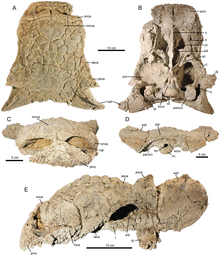| Ziapelta Temporal range: Campanian,
| |
|---|---|

| |
| Holotype skull | |
| Scientific classification | |
| Domain: | Eukaryota |
| Kingdom: | Animalia |
| Phylum: | Chordata |
| Clade: | Dinosauria |
| Clade: | †Ornithischia |
| Clade: | †Thyreophora |
| Clade: | †Ankylosauria |
| Family: | †Ankylosauridae |
| Subfamily: | †Ankylosaurinae |
| Tribe: | †Ankylosaurini |
| Genus: | †Ziapelta Arbour et al., 2014 |
| Type species | |
| †Ziapelta sanjuanensis | |
Ziapelta is an extinct genus of ankylosaurid. Its fossils have been found in the Hunter Wash and De-na-zin members of the Kirtland Formation of Upper Cretaceous (Campanian) New Mexico. It was named in 2014, in a research paper led by ankylosaur researcher Victoria Arbour. There is a single species in the genus, Ziapelta sanjuanensis. The genus is named after the Zia sun symbol, a stylized sun with four groups of rays, having religious significance to the Zia people of New Mexico, and the iconic symbol on the state flag of New Mexico, and pelta (Latin), a small shield, in reference to the osteoderms found on all ankylosaurids. The specific name is in reference to San Juan County and the San Juan basin, where the fossils were found. Multiple specimens have been described to date, though the fossils are mostly from the front part of the animal. Its closest relative appears to be either Scolosaurus or Nodocephalosaurus, depending on what cladistic model is used.